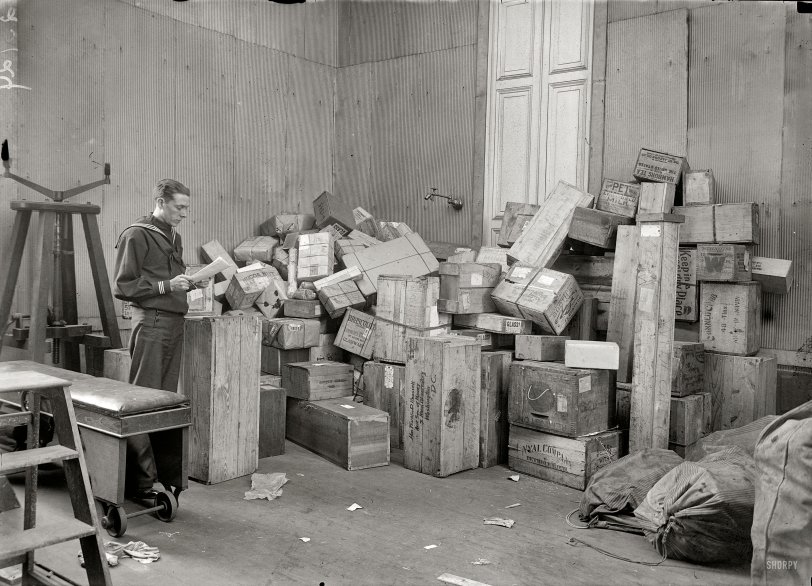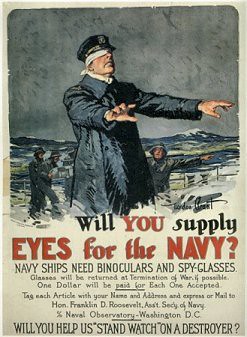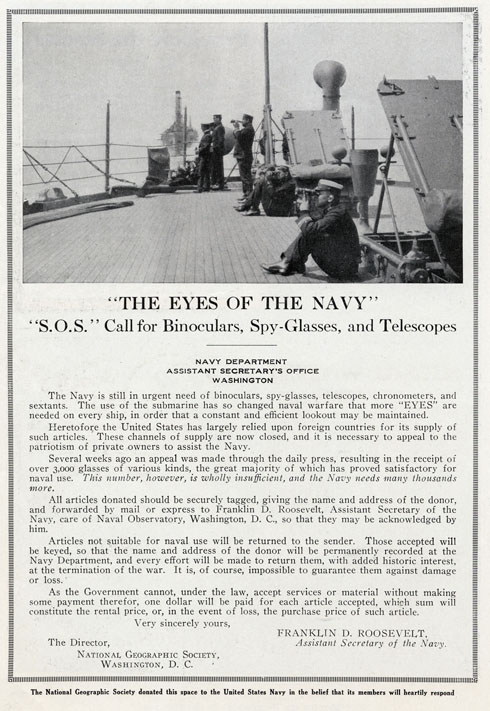


Framed or unframed, desk size to sofa size, printed by us in Arizona and Alabama since 2007. Explore now.
Shorpy is funded by you. Patreon contributors get an ad-free experience.
Learn more.

- Baldwin 62303
- Baldwin VO-1000
- Cold
- No expense spared
- Tough Guys
- Lost in Toyland
- And without gloves
- If I were a blindfolded time traveler
- Smoke Consumer Also Cooks
- Oh that stove!
- Possibly still there?
- What?!?
- $100 Reward
- Freeze Frame
- Texas Flyer wanted
- Just a Year Too Soon
- WWII -- Replacing men with women at the railroad crossing.
- Yes, Icing
- You kids drive me nuts!
- NOT An Easy Job
- I wonder
- Just add window boxes
- Icing Platform?
- Indiana Harbor Belt abides
- Freezing haze
- Corrections (for those who care)
- C&NW at Nelson
- Fallen Flags
- A dangerous job made worse
- Water Stop
Print Emporium
To FDR: 1918

Washington, 1918. "Navy Dept. stores." Everything here seems to be addressed to "Hon. Franklin D. Roosevelt, Asst. Sec. of Navy, c/o Naval Observatory." Who can hazard a guess as to what might be in these boxes? View full size.
The Light on the wall
It looks like a gas light fixture that had been converted to electricity, though I don't know why it wouldn't have a bulb in it in that case. But it looks like a standard Edison base socket with a key switch pointed back toward the wall.
(I've seen other cases in which a gas light was converted by simply replacing the mantle with a lamp socket and using the gas pipe as improvised electrical conduit.)
In those crates...
At least two crates bear imprints from a lighting fixture company and a mineral water supplier. The one marked Brascolite is from a firm that specialized in institutional and commercial ceiling light fixtures. Near the top of the crate pile is one marked French Lick, a mineral water from Indiana.
Put those crates in any modern antique store and you could probably fetch $25 minimum per each! Anyone from 1918 wouldn't be able to believe that might ever be possible.
Keyed up, Keyed in
I grew up with that "keyed" term as well, which marks me as another fogey....and when I use it with anyone younger than 40 they just gawp at me.
Eyes of the Navy
Can anyone tell me which 1918 issue of National Geographic (and the page) where this "Eyes Of the Navy" notice appeared? I own an original "Eyes for the Navy" Poster (created by Gordon Grant) and a thank-you letter signed by FDR to one of my relatives who made a donation to the Navy, and I found the National Geographic notice most interesting.
I went to a nearby university library and examined the bound volumes of National Geographic for 1918 looking for the "Eyes of the Navy" notice, but didn't find it. Apparently only the published articles were included when the 1918 issues were consolidated into bound volumes -- I checked page-by-page and the notice was not there. Can anyone tell me the issue/page where it originally appeared?
Robert Voigt
To key
One meaning of the word key as a transitive verb is to associate or cross-reference one item with another. Not much in use today, but I immediately understood that usage in the article, thereby keying myself with other old fogeys.
Added Historic Interest
I love the sentence in the National Geographic ad: "Those accepted will be keyed(?) so that the name and address of the owner will be permanently recorded at the Navy Department, and every effort will be made to return them, with added historic interest, at the termination of the war."
I suppose it could make for an interesting story: "What did you do in the Great War daddy?" "Well son, I had flat feet so I stayed a civilian and sold life insurance. My binoculars, on the other hand, served on the USS Pennsylvania. Here's the paper to prove it."
The only thing I wonder about is the term "keyed." Do they mean that the items would have something engraved on them indicating their ownership, or would detailed information be recorded on a file card somewhere and at the end of the war the item and the card would be matched up and the item sent off to the proper owner. And how many never made it back to the rightful owner because of bureaucratic errors rather than enemy action.
Eyes of the Navy
From a 1918 National Geographic (more here). Click below to enlarge.
It's a jack!
It appears to me that the crank thing doesn't just spin the armature - it has wheels on the top, and a screw down below, so apparently turning the crank raises the turning armature above to lift a ceiling or something, perhaps for raising houses to put supports under it.
[That's a U-shaped bracket on the left side of the armature, not a wheel. Maybe something to do with signaling, or telescopes. - Dave]
Crazy Legs
Hi. This is an interesting photo. I wonder why the subject's legs seem to be at a funny angle when viewed though the legs of the rolling bench. Something does not seem to match up.
[You're seeing the curve of the bench leg as the curve of his leg. - Dave]
Antiques Roadshow
I recently saw an "Antiques Roadshow" featuring a small pair of binoculars that were donated in 1918 by the owner's grandmother in response to the Navy's request. What was surprising was that after the war the government returned her binoculars to her with a thank-you letter signed by Roosevelt (also seen on the episode), and that the government had actually found a way to keep track of these donations. The lady's binoculars had apparently been used on a merchant ship, one which, needless to say, had not been sunk during the war.
Oddities abound
The cart with very stout wheels and a padded top seems passing strange as well.
And what is that on the wall next to the door? Some sort of gas lamp? (Yeah, an open flame is just the thing to have in a dusty room full of wooden crates!)
The geared mechanism appears to be a (printing?) press of some kind.
[It's not a press. It has a side crank that spins the armature on top. - Dave]
Shipping Technology
One of the first things that struck me was the advancement in packaging and shipping technology. Those wood cased boxes would cost a fortune to ship today.
[Back in the Olden Tymes, those were called "crates." - Dave]
And what is that ... device?
I'm curious about that geared mechanism on the derrick there behind the sailor. Any idea what that is?
Eyes For the Navy
Since the cat is already out of the bag.....
Navy Would Use Old Binoculars
Cannot Make Enough.
People Asked to Give Glasses.To supply "Eyes for the Navy," the National Committee of Patriotic Societies, representing 42 national organizations, is cooperating with the Four-Minute Men in a drive extending from Lincoln's birthday to Washington's birthday. The recent expansion of the navy has caused a serious shortage in binoculars, spyglasses, telescopes, chronometers, and sextants on our war vessels of all types. The few factories which make these instruments in the United States have orders far beyond their capacity.
"In the homes of America are thousands of unused instruments of the kind needed." Says a statement yesterday: "If these are promptly located and sent to Washington their use may prevent the sinking of another transport, or may be the means of destroying a submarine. All articles should be securely tagged with the name and address of owner and forwarded by mail or express to Franklin Roosevelt, care Naval Observatory, Washington. As the government cannot, under law, accept services or material without some payment, $1 will be paid for each article.
Washington Post, Feb 11, 1918

Binoculars?
The "glass" labels could be a clue. In both world wars the Navy requested civilians to send any kind of optical devices that could help outfit naval crews.
[That didn't take long. Right on the first guess! - Dave]

























On Shorpy:
Today’s Top 5